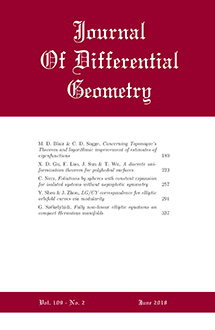Abstract
In this paper, we study the theory of linearized gravity and prove the linear stability of Schwarzschild black holes as solutions of the vacuum Einstein equations. In particular, we prove that solutions to the linearized vacuum Einstein equations centered at a Schwarzschild metric, with suitably regular initial data, remain uniformly bounded and decay to a linearized Kerr metric on the exterior region. We employ Hodge decomposition to split the solution into closed and co-closed portions, respectively identified with even-parity and odd-parity solutions in the physics literature. For the co-closed portion, we extend previous results by the first two authors, deriving Regge–Wheeler type equations for two gauge-invariant master quantities without the earlier paper’s need of axisymmetry. For the closed portion, we build upon earlier work of Zerilli and Moncrief, wherein the authors derive an equation for a gauge-invariant master quantity in a spherical harmonic decomposition. We work with gauge-invariant quantities at the level of perturbed connection coefficients, with the initial value problem formulated on Cauchy data sets. With the choice of an appropriate gauge in each of the two portions, decay estimates on these decoupled quantities are used to establish decay of the metric coefficients of the solution, completing the proof of linear stability. Our result differs from that of Dafermos–Holzegel–Rodnianski, both in our choice of gauge and in our identification and utilization of lower-level gauge-invariant master quantities.
Citation
Pei-Ken Hung. Jordan Keller. Mu-Tao Wang. "Linear stability of Schwarzschild spacetime: Decay of metric coefficients." J. Differential Geom. 116 (3) 481 - 541, November 2020. https://doi.org/10.4310/jdg/1606964416





